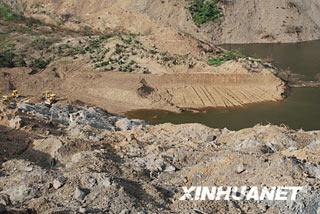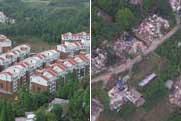China
Giant barrier lake closely monitored
WATCH VIDEO
Source: CCTV.com | 06-04-2008 13:27
Special Report: Strong quake jolts SW ChinaThe General Engineer from China's Ministry of Water Resources, Liu Ning says Tangjiashan barrier lake looks almost certain to burst its banks. But he also says safety measures that are already in place will reduce potential threats from the giant quake-formed lake. Downstream from the city of Mianyang, more than 250,000 residents have been evacuated to safer areas.
 |
| Tangjiashan barrier lake looks almost certain to burst its banks. |
Liu Ning is the head of the team of experts commanding the disaster relief operation at Tangjiashan quake lake. The barrier lake is the largest of its kind. These lakes were formed when landslides triggered by the devastating earthquake blocked rivers. He says the water level of the lake reached nearly 737 meters as of 4 pm on Tuesday. The total water volume in the lake has reached over 205 million cubic meters. And the water level of the lake keeps rising more than 1.5 meters each day. At this rate of speed, the lake is expected to overflow its banks and run into the diversion channel in a day or two.
Liu Ning says the Tangjiashan lake area has entered into its rainy season period. He notes that every 2 millimeters of precipitation in the river valley of the lake -- will push its water level -- one meter higher. Meanwhile, there are also frequent aftershocks and other secondary geological threats.
Liu Ning said "After repeated surveys, we determined that landslides are likely to occur on a huge slope near Xuanping Township. That area has already been submerged by the Tangjiashan barrier lake. Once the landslide erupts, it would generate huge tidal waves in the lake, thus prompting the lake to burst in a very short time."
The nearly 1,000-member work force of armed police soldiers and experts left after the completion of the 475-meter-long diversion channel 3 days ago. But a small squadron of 18 members are standing by to keep a constant watch over the lake. They are using high-tech means to help them detect any signs of variations on the lake.
The remote video-monitoring system developed by the Chinese Academy of Sciences surveys the 3,500 square kilometer upstream area of the lake around-the-clock. Via broad-band wireless technology, the real time data can be transmitted to satellites and the hydrological monitoring center in Mianyang. As a result, experts are continuously updated with the latest information about the water level of the lake and the status of the blockage.
Yang Hongsheng, Professor of Micro-System & Information Tech. Institute of CAS said "There are 5 monitoring points scattered around the mountains near the blockage. We can see from here two points in the forest in front of the blockage. One is an ultra-red night-viewing device. Another is used to do monitoring in daytime. The data they collect can be quickly processed and transmitted to satellites."
Experts say the current relief operation comprises diversion projects and massive evacuation in potentially dangerous areas. Authorities have worked out a comprehensive emergency-response plan. The safety of the people is the plan's topmost priority. Downstream from the city of Mianyang, more than 250,000 residents have been evacuated to 252 settlement points. The sites provide access to basic living and sheltering needs. These contingency plans aim to deal with any potential emergency including the possibility of one third of the lake's volume of water bursting over its banks. Meanwhile, more drills are underway in the city to prepare for even worse scenarios.
Editor:Xiong Qu



